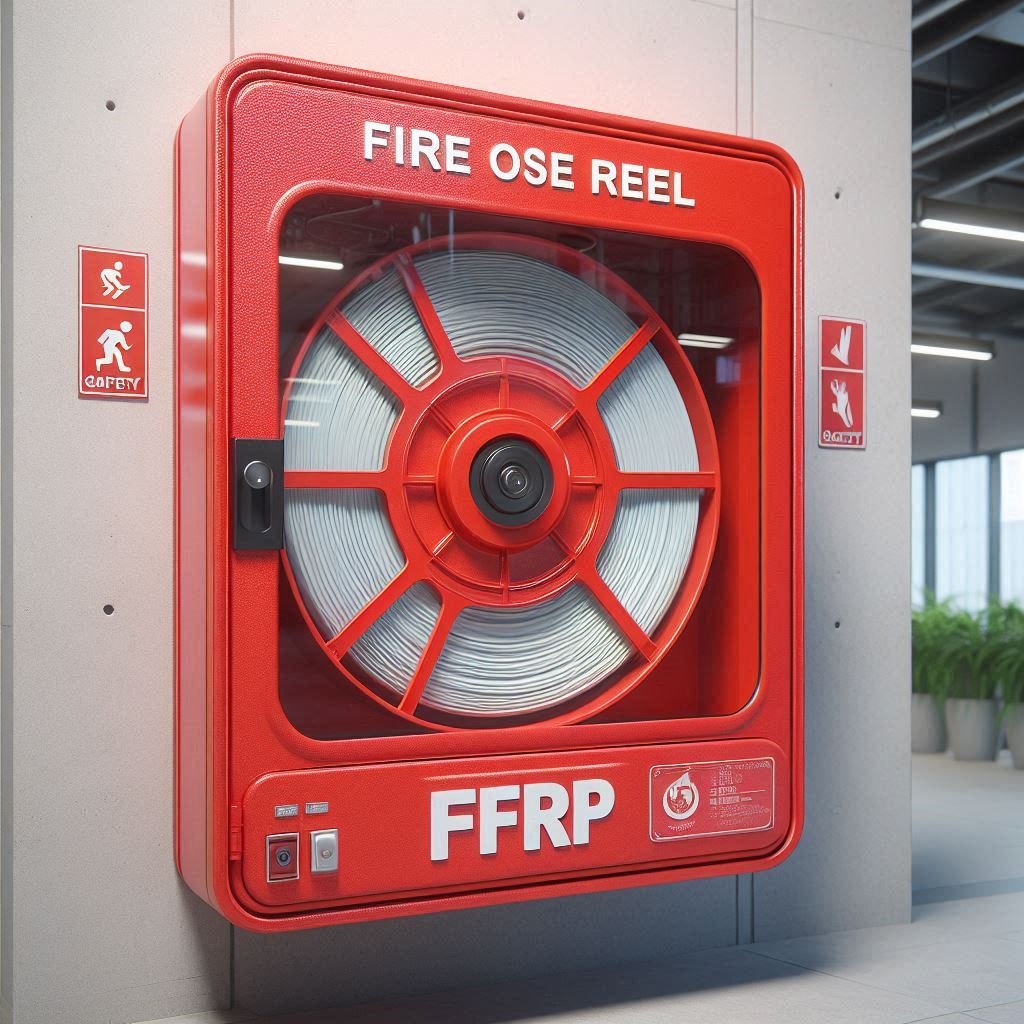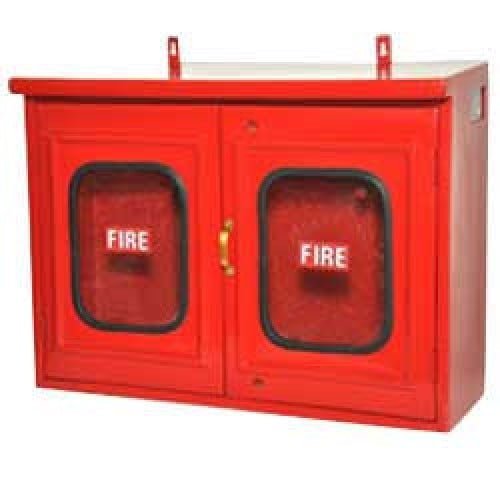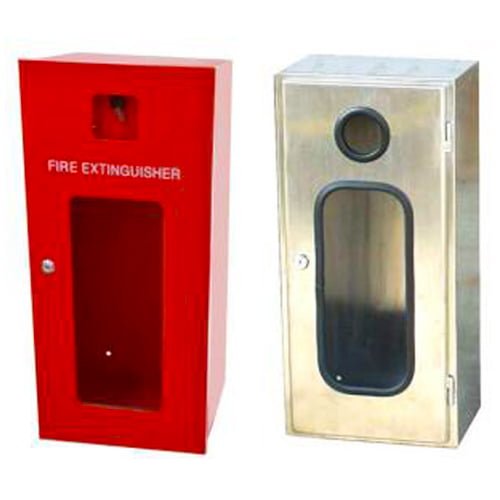Ultimate 8 Factors while Selecting Fire Hose Boxes : FRP vs Mild Steel vs Stainless Steel
Introduction:
Fire Hose Boxes or Fire Storage Boxes of Fire Extinguisher Boxes are essential components of fire safety systems which ensures quick access to firefighting equipment like fire hose pipes, nozzles, Fire fighting accessories, Fire Extinguishers etc. during fire emergencies.
Choosing the right material for these fire equipment storage boxes from FRP (Fiber Reinforced Plastic), mild steel, or stainless steel requires understanding their properties, costs, safety features, environmental impact, design possibilities, and other factors.



In this comprehensive blog, we will delve into these aspects to guide you in making an informed decision.
1. Material Properties and Performance:
- ✓ Overview: Understanding the material properties and performance of Fire Hose Boxes or Fire Storage Boxes or fire extinguisher boxes is crucial for ensuring their effectiveness and durability. All these boxes are also known as fire hose cabinets or fire storage cabinets or fire extinguisher cabinets.
- ✓ Key Focus: This section explores the strengths, weaknesses, and overall performance of FRP, mild steel, and stainless steel material in the context of fire hose boxes or fire storage boxes.
- ✓ Importance: Material properties such as durability, corrosion resistance, weight, and maintenance needs directly impact the safety and reliability of fire hose boxes or fire storage boxes.
- ✓ Objective: Provide a comprehensive comparison to help you select the most suitable material for your fire safety equipment needs.
Durability and Strength:
When it comes to durability and strength, each material offers distinct advantages. Mild steel provides significant strength and is highly durable, making it suitable for heavy-duty applications. Stainless steel, known for its superior strength and corrosion resistance, is ideal for harsh environments. FRP, while not as strong as steel, offers excellent durability with lightweight properties, making it easy to handle and install.
Corrosion Resistance:
Corrosion is a major concern for fire hose boxes or fire storage boxes. Stainless steel excels in this regard due to its chromium content, which forms a protective layer against rust. Mild steel, though strong, is prone to rust and requires regular maintenance. FRP, being a composite material, is inherently resistant to corrosion, making it a great choice for environments where moisture or chemicals are present.
Key Takeaway
Remember these important insights as you continue reading.
Weight Considerations:
Weight is a crucial factor in the installation and maintenance of fire hose boxes. FRP is the lightest among the three materials, offering ease of installation and reducing the structural load on buildings. Mild steel is heavier but provides robustness. Stainless steel, while heavier than FRP, balances weight and strength effectively.
Maintenance Requirements:
Maintenance is vital for the longevity of fire hose boxes. FRP requires minimal maintenance due to its corrosion resistance and durability. Mild steel needs regular painting and inspections to prevent rust. Stainless steel, though more resistant to corrosion, still benefits from occasional cleaning to maintain its appearance and performance.
2. Cost Analysis and Economic Factors:
- ✓ Overview: An in-depth look at the cost implications of selecting the appropriate material for Fire Hose Boxes or Fire Storage Boxes or fire extinguisher boxes, encompassing initial investment, long-term expenses, and overall value.
- ✓ Key Focus: Evaluating the initial cost, lifecycle cost, installation expenses, and return on investment (ROI) for fire hose boxes made from FRP, mild steel, and stainless steel.
- ✓ Importance: Understanding the economic factors helps in making informed decisions that balance upfront costs with long-term benefits, ensuring the financial sustainability and effectiveness of fire safety measures.
- ✓ Objective: To provide a comprehensive analysis that assists stakeholders in selecting the most cost-effective material for Fire Hose Boxes or Fire Storage Boxes, optimizing both budget and performance.
If you are looking to learn more about Hose Reel Drum Cabinets
If you are looking for any types of fire fighting equipment from India you can visit our website at www.kindefire.co.in / www.firefightingequipment.co.in / www.ithing-mtx.com.
You can also email us at info@kindefire.co.in or hrathod@ithing-mtx.com
Initial Cost:
The initial cost of fire hose boxes varies significantly among the three materials. Mild steel is typically the most affordable option upfront. Stainless steel comes with a higher initial cost due to its material properties and manufacturing processes. FRP falls in the middle, offering a balance between cost and performance.
Key Takeaway
Remember these important insights as you continue reading.
Lifecycle Cost:
Considering the lifecycle cost provides a clearer picture of long-term expenses. Mild steel, despite its low initial cost, incurs higher maintenance and replacement costs. Stainless steel, while expensive initially, proves cost-effective over time due to its durability and low maintenance needs. FRP offers a good balance, with moderate initial and lifecycle costs, making it a cost-effective option in the long run.
Installation Costs:
Installation costs are influenced by the weight and ease of handling of the materials. FRP, being lightweight, reduces labor and equipment costs during installation. Mild steel, due to its weight, might require more effort and specialized equipment, increasing installation expenses. Stainless steel, though heavier, benefits from its strength, potentially reducing installation complications.
Return on Investment:
The return on investment (ROI) for fire hose boxes depends on their performance, maintenance, and longevity. Stainless steel offers the highest ROI due to its durability and minimal maintenance needs. FRP provides a good ROI with its balance of cost and performance. Mild steel, while affordable initially, may offer lower ROI due to higher maintenance and replacement costs.
3. Fire Resistance and Safety:
- ✓ Overview: Fire resistance and safety are critical factors in selecting the appropriate material for Fire Hose Boxes or Fire Storage Boxes. Ensuring these boxes perform well under fire conditions can be the difference between effective firefighting and disaster.
- ✓ Key Focus: This section compares the flammability, fire ratings, smoke and toxicity levels, and safety standards compliance of FRP, mild steel, and stainless steel fire hose boxes.
- ✓ Importance: Understanding how each material behaves in fire scenarios helps in choosing boxes that not only protect the stored firefighting equipment but also enhance overall safety during emergencies.
- ✓ Objective: To provide a comprehensive comparison of fire resistance and safety features among FRP, mild steel, and stainless steel, guiding you to make an informed decision for the safest fire hose boxes or fire storage boxes.
Flammability and Fire Ratings:
Fire resistance is paramount for fire hose boxes. Stainless steel is non-combustible and maintains its structural integrity in high temperatures, making it highly reliable. Mild steel also offers good fire resistance but may lose strength at high temperatures. FRP, while generally fire-resistant, can vary in performance based on its composition and additives.
Key Takeaway
Remember these important insights as you continue reading.
Smoke and Toxicity:
In fire scenarios, the production of smoke and toxic gases is a critical consideration. Stainless steel and mild steel do not produce smoke or toxic fumes. FRP, depending on its resin and additive composition, might produce smoke and toxic gases, requiring careful selection of fire-resistant grades.
Safety Standards Compliance:
Compliance with safety standards ensures the reliability of fire hose boxes. Stainless steel and mild steel generally meet or exceed most safety standards. FRP, due to its variability, must be specifically tested and certified to ensure compliance with relevant fire safety regulations.
Performance in Fire Scenarios:
Real-world performance during fire incidents is a testament to material reliability. Stainless steel maintains its integrity and protects the stored equipment. Mild steel performs well but may deform under extreme heat. FRP, with appropriate fire-resistant grades, offers reliable performance but requires thorough testing to confirm its suitability.
4. Environmental Impact and Sustainability:
-
✓
Overview: Assessing the environmental impact and sustainability of materials used for Fire Hose Boxes or Fire Storage Boxes is essential for making eco-friendly choices.
-
✓
Key Focus: This section examines the environmental footprint, recyclability, sustainable practices, and regulatory compliance of FRP, mild steel, and stainless steel fire hose boxes.
-
✓
Importance: Understanding these factors helps in selecting materials that minimize environmental harm and contribute to sustainable practices in fire safety equipment.
- ✓ Objective: To provide insights into how each material affects the environment and promotes sustainability, ensuring that fire hose boxes not only protect lives but also the planet.
Environmental Footprint:
The environmental impact of materials is a growing concern. Stainless steel, despite its energy-intensive production, is highly recyclable, reducing its overall footprint. Mild steel also benefits from recyclability but involves higher environmental costs in production and maintenance. FRP, being a composite material, has a lower initial environmental footprint but poses recycling challenges.
Recyclability:
Recyclability is a significant factor in material selection. Stainless steel is 100% recyclable, making it an environmentally friendly option. Mild steel is also highly recyclable, contributing to a circular economy. FRP, while more challenging to recycle, can be repurposed or disposed of with less environmental impact than expected.
Key Takeaway
Remember these important insights as you continue reading.
Sustainability Practices:
Sustainable sourcing and manufacturing practices enhance the environmental credentials of materials. Stainless steel manufacturers are increasingly adopting sustainable practices. Mild steel production is improving in terms of energy efficiency and emissions reduction. FRP manufacturers are exploring bio-based resins and recycling methods to improve sustainability.
Regulatory Compliance:
Compliance with environmental regulations is crucial for material selection. Stainless steel and mild steel typically comply with stringent environmental regulations. FRP must be selected with care to ensure it meets local and international environmental standards, particularly regarding emissions during production and disposal.
5. Aesthetic and Design Considerations:
-
✓
Overview: Exploring the visual appeal, customization options, and integration possibilities of Fire Hose Boxes or Fire Storage Boxes.
-
✓
Key Focus: Evaluating the aesthetic qualities, color and finish options, and design flexibility of fire hose boxes made from FRP, mild steel, and stainless steel.
-
✓
Importance: Understanding the impact of aesthetics and design on the overall appearance and functionality of fire safety equipment, particularly in visible or public areas.
- ✓ Objective: To guide the selection of fire hose boxes that not only meet safety and performance standards but also enhance the visual and architectural integration of the space.
Visual Appeal:
Aesthetic considerations influence the choice of fire hose boxes, especially in visible or public areas. Stainless steel offers a sleek, modern look that complements various architectural styles. Mild steel, though less visually appealing, can be painted or coated for better aesthetics. FRP offers versatility in design, allowing for various colors, finishes, and textures.
Customization Options:
Customization options enhance the functionality and visual appeal of fire hose boxes. Stainless steel can be customized with different finishes and coatings. Mild steel offers flexibility in design but may require additional coatings for aesthetic purposes. FRP excels in customization, allowing for various shapes, colors, and integrated features.
Color and Finish Options:
Color and finish options impact the visual integration of fire hose boxes. Stainless steel provides a polished or brushed finish. Mild steel can be painted in any color but requires maintenance to preserve the finish. FRP offers an extensive range of colors and textures, allowing for seamless integration with the surrounding environment.
Key Takeaway
Remember these important insights as you continue reading.
Architectural Integration:
The ability to blend with architectural designs is crucial for fire hose boxes. Stainless steel integrates well with modern and industrial styles. Mild steel, though less adaptable, can be designed to match traditional and utilitarian settings. FRP’s versatility allows it to fit into a wide range of architectural styles, from contemporary to classic.
6. Application and Suitability:
-
✓
Overview: Analyzing the ideal environments and conditions where FRP, mild steel, and stainless steel fire hose boxes excel.
-
✓
Key Focus: Examining the performance, versatility, and adaptability of each material in different settings, such as industrial, commercial, and residential.
-
✓
Importance: Highlighting the significance of selecting the appropriate material to ensure durability, safety, and compliance with industry standards in specific applications.
- ✓ Objective: Providing insights to help make informed decisions on the most suitable material for fire hose boxes or fire storage boxes based on specific environmental and operational needs.
Usage Scenarios:
Different environments require specific material properties. Stainless steel is ideal for high-corrosion areas like marine and industrial settings. Mild steel suits controlled environments where cost is a priority. FRP is versatile, performing well in diverse environments including chemical plants, coastal areas, and urban settings.
Performance in Extreme Conditions:
Performance in extreme conditions is a vital consideration. Stainless steel withstands high temperatures and corrosive environments. Mild steel performs well in moderate conditions but may require protective coatings in harsh environments. FRP, with its inherent corrosion resistance and lightweight properties, excels in extreme conditions.
Versatility:
Versatility determines the adaptability of fire hose boxes. Stainless steel offers robust performance in various applications but may be limited in design flexibility. Mild steel is versatile but requires maintenance. FRP stands out with its adaptability in design and performance across different environments.
Industry-specific Applications:
Certain industries have specific requirements for fire hose boxes. Stainless steel is preferred in pharmaceutical, food processing, and marine industries due to its hygiene and corrosion resistance. Mild steel suits construction and manufacturing industries where cost-efficiency is crucial. FRP is favored in chemical plants, coastal areas, and industries requiring lightweight, corrosion-resistant solutions.
Key Takeaway
Remember these important insights as you continue reading.
7. Manufacturing and Production:
-
✓
Overview: Manufacturing and production processes involve the creation of fire hose boxes from materials such as FRP, mild steel, and stainless steel. Each material undergoes specific techniques to ensure structural integrity and compliance with safety standards.
-
✓
Key Focus: The primary focus is on precision manufacturing techniques, including molding for FRP, welding for mild steel, and fabrication for stainless steel, to achieve optimal performance and longevity.
-
✓
Importance: Quality manufacturing ensures fire hose boxes meet stringent safety regulations and performance standards, crucial for reliability during emergency situations.
- ✓ Objective: The objective is to produce fire hose boxes that are durable, corrosion-resistant, and capable of withstanding diverse environmental conditions, enhancing overall fire safety measures.
Manufacturing Processes:
Understanding manufacturing processes helps in assessing material suitability. Stainless steel production involves complex processes like forging, welding, and finishing. Mild steel manufacturing is straightforward but requires protective coatings. FRP manufacturing involves molding and curing, allowing for complex shapes and designs.
Lead Times and Availability:
Lead times and material availability impact project timelines. Stainless steel and mild steel are widely available, ensuring short lead times. FRP, though increasingly popular, may have longer lead times due to specialized manufacturing processes.
Quality Control:
Quality control ensures the reliability of fire hose boxes. Stainless steel undergoes rigorous testing for strength and corrosion resistance. Mild steel requires regular inspections to ensure coating integrity. FRP quality depends on the consistency of resin and fiber used, necessitating thorough testing.
Technological Advances:
Technological advances enhance material performance. Stainless steel benefits from innovations in alloy composition and manufacturing techniques. Mild steel sees improvements in coatings and corrosion resistance technologies. FRP evolves with advancements in resin formulations, fiber reinforcement, and manufacturing processes.
8. Installation and Maintenance:
-
✓
Overview: Installing and maintaining Fire Hose Boxes or Fire Storage Boxes is pivotal for ensuring optimal functionality and reliability in emergency situations.
-
✓
Key Focus: Understanding the precise installation procedures and ongoing maintenance requirements specific to each material—FRP, mild steel, and stainless steel—used in fire hose boxes.
-
✓
Importance: Proper installation guarantees that the fire safety equipment is readily accessible and operational when needed, while regular maintenance ensures longevity and operational efficiency.
- ✓ Objective: The primary objective is to adhere to safety standards, prolong the service life of the equipment, and minimize downtime through proactive maintenance practices.
Installation Procedures:
Proper installation ensures the effectiveness of fire hose boxes. Stainless steel and mild steel require skilled labor and specialized equipment for installation. FRP, being lightweight, simplifies installation, reducing labor and equipment costs.
Key Takeaway
Remember these important insights as you continue reading.
Maintenance Schedules:
Maintenance schedules vary among materials. Stainless steel requires minimal maintenance, focusing on cleaning and occasional inspections. Mild steel needs regular painting and rust prevention measures. FRP requires minimal maintenance due to its corrosion resistance.
Repairability:
Repairability impacts the long-term viability of fire hose boxes. Stainless steel is easily repairable with welding and polishing. Mild steel can be repaired but requires rust treatment. FRP repairs involve resin application and curing, which can be more complex.
Common Issues and Solutions:
Common issues include corrosion, impact damage, and fire resistance. Stainless steel’s main issue is surface damage, which is easily polished. Mild steel faces rust, addressed by regular painting. FRP can suffer from UV degradation, mitigated by UV-resistant coatings.
Conclusion:
Choosing the right material for Fire Hose Boxes or Fire Storage Boxes of Fire Extinguisher Boxes involves balancing multiple factors, including material properties, costs, safety features, environmental impact, and application suitability. Stainless steel offers superior durability and low maintenance, ideal for harsh environments. Mild steel is cost-effective but requires regular upkeep. FRP provides versatility, lightweight properties, and corrosion resistance, making it suitable for various applications.
By understanding these factors, you can make an informed decision that ensures the safety, reliability, and longevity of your fire safety equipment.
Pingback: 9 Step Guide Comprehensive Guide on Installation of Fire Hose Reel Cabinets: -
Pingback: 5 Key Reasons Why Extinguisher Fire Cabinets are Essential for Workplace Safety -
Pingback: Best Comparison Surface-Mounted vs. Recessed Fire Extinguisher Cabinets -